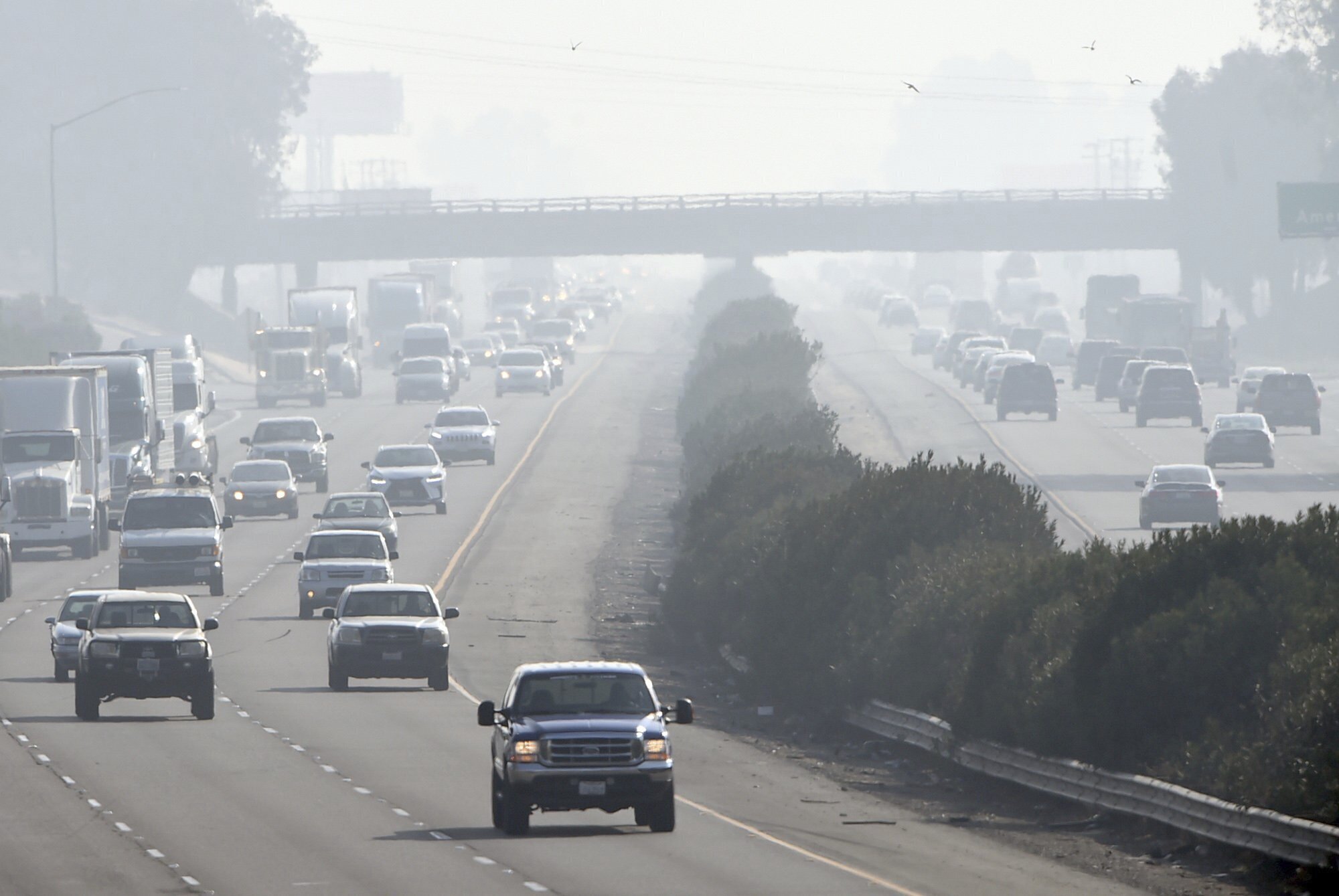California has dramatically improved its air quality, but racial disparities persist
The state’s aggressive emissions policies have reduced exposure to PM2.5 air pollution by 65% since 2000, but low-income communities of color still breathe the dirtiest air.

John Walker/The Fresno Bee via AP
September 11, 2024
A Spanish version of this article is available.
Californians breathe much cleaner air today than they did 25 years ago. That’s according to a new study published today in Science Advances, which found that the state’s aggressive emissions policies have reduced residents’ exposure to PM2.5 pollution — fine particulate matter in the air — from cars, trucks and other vehicles by 65% since 2000.
But these policies fall short in one key area. While Hispanics and Black Californians — the groups exposed to the highest levels of vehicle pollution — have seen the largest reductions in PM2.5 pollution, California’s large and longtime racial disparities in exposure to vehicle air pollution persist.
“California has been remarkably effective at controlling pollution from on-road emission sources, from cars and light-duty trucks to heavy-duty vehicles,” said study senior author Joshua Apte, associate professor in the Department of Civil and Environmental Engineering and the School of Public Health at UC Berkeley. “This is a tremendous win for public health, but our work isn’t done, because there’s been no narrowing of the relative gap between the most exposed and least exposed racial and ethnic groups.”
Fine particulate matter air pollution is linked to a wide range of adverse health effects and has been estimated to cause more than 5,000 premature deaths in California each year. Emissions from light-duty vehicles, like cars, are the main sources of exposure, although contributions from heavy-duty vehicles, such as port drayage trucks, have a higher impact on overburdened communities.
Historically in the U.S., racist housing policies, including redlining, have forced communities of color to live closer to highways and ports than predominantly white communities, and subsequently to breathe higher levels of air pollution. However, the new study adds to a growing body of evidence suggesting that targeting vehicle emissions alone will not be enough to close the air quality gap, even if emissions are reduced to nearly zero.
“We found that the biggest absolute reductions in air pollution over the past two decades happened in black and brown communities, but the relative disparities have remained nearly constant,” Apte said. “One of the things that we’ve learned through this work is that we’re not actually going to get rid of the relative disparities from vehicles, even when they’re all electric, because things like tires and brakes will still give off emissions.”
California enacted the nation’s first vehicle emissions standards in 1966, four years before the federal Clean Air Act, and has continued to lead the U.S. in air quality policy. Recent vehicle emission control programs implemented by the California Air Resources Board (CARB) include the Truck and Bus regulation, which targets emissions from heavy-duty diesel vehicles, and the Zero-Emission Vehicle Program, which requires that all new vehicles in California be zero-emission by 2035.
To evaluate how these policies impacted PM2.5 pollution concentrations in California, the researchers used CARB’s EMissions FACtor regulatory model, which includes estimates of on-road emissions from 2000 to 2019, broken down by vehicle type. They also created a new open-source tool called ECHO-AIR, which takes emissions data from any sector — including vehicles, power plants or industrial manufacturing — and estimates their impact on PM2.5 exposure.
“The benefit of using this modeling tool is that we can isolate just the impact of California’s mobile-source emissions across two decades of time. You can’t really do that with air quality measurements or satellite observations,” said study first author Libby Koolik, a graduate student in environmental engineering at UC Berkeley. “Another benefit is that we can estimate PM2.5 exposure at a high spatial resolution; our grid cells go down to 1 kilometer in really populated places. This allows us to do these really important exposure and disparity assessments.”
Reducing air pollution disparities will require paying greater attention to systemic factors, such as shifting where emissions occur, the researchers said. CARB’s strategies to accelerate the adoption of zero-emission cars and trucks in overburdened communities could also achieve significant reductions in relative PM2.5 exposure disparities.
“As long as vehicles and vehicle emissions are disparately concentrated in overburdened communities, those communities are going to have a higher share of the overall exposure,” Apte said. “California’s increasing focus on policies that can bring down emissions in places that are historically overburdened, such as accelerated retirement of dirty old vehicles that operate near ports and rail yards, is one way to address these disparities. Another more difficult way is through urban planning. Highways are disproportionately concentrated in some neighborhoods and not others, and we have to spread that burden around more equally if we want to ultimately get rid of these disparities.”
This study was a collaboration between UC Berkeley, University of Washington and the California Environmental Protection Agency’s Office of Environmental Health Hazard Assessment (OEHHA). Additional co-authors include Álvaro Alvarado, Amy Budahn and Laurel Plummer of OEHHA; and Julian D. Marshall of the University of Washington. Funding was provided by OEHHA.
Read the full press release on the OEHHA public information site.